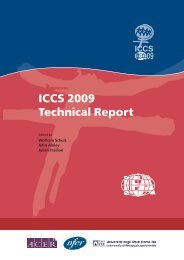Teacher Education and Development Study in Mathematics - IEA
Teacher Education and Development Study in Mathematics - IEA
Teacher Education and Development Study in Mathematics - IEA
You also want an ePaper? Increase the reach of your titles
YUMPU automatically turns print PDFs into web optimized ePapers that Google loves.
PART 2: FINLAND<br />
79<br />
F<strong>in</strong>l<strong>and</strong><br />
Composition of the teacher labor force<br />
F<strong>in</strong>l<strong>and</strong>’s education system employed about 66,000 F<strong>in</strong>nish- <strong>and</strong> Swedish-speak<strong>in</strong>g<br />
<strong>in</strong>structors <strong>in</strong> 2002. Of this number, 45,568 were teach<strong>in</strong>g <strong>in</strong> primary <strong>and</strong> lowersecondary<br />
schools, 7,846 were teach<strong>in</strong>g <strong>in</strong> general upper-secondary schools, <strong>and</strong> 12,486<br />
were work<strong>in</strong>g with<strong>in</strong> vocational education. The numbers have decl<strong>in</strong>ed somewhat <strong>in</strong><br />
subsequent years, accord<strong>in</strong>g to the World Bank’s World <strong>Development</strong> Indicators. Just<br />
over 90% of the entire teach<strong>in</strong>g cohort works full-time. The majority of teachers are<br />
female, with 75% <strong>in</strong> primary <strong>and</strong> lower-secondary schools <strong>and</strong> 67% <strong>in</strong> upper-secondary<br />
schools. N<strong>in</strong>ety-five percent of the teachers <strong>in</strong> the general upper-secondary schools <strong>and</strong><br />
75% of the teachers <strong>in</strong> vocational education had formal qualifications. There were also<br />
about 20,000 class (primary) <strong>and</strong> preschool teachers <strong>and</strong> approximately 16,400 subjectspecialist<br />
teachers.<br />
F<strong>in</strong>l<strong>and</strong>’s teachers are generally older than teachers <strong>in</strong> other countries. Age distributions<br />
show that the largest number of upper-secondary school teachers is <strong>in</strong> the 50 to 59 year<br />
range, while the largest number of basic-education teachers is <strong>in</strong> the 40 to 49 <strong>and</strong> the<br />
50 to 59 year ranges. There are also relatively few vocational education teachers under<br />
30 years of age, as these teachers usually acquire ample work experience before they<br />
enter schools. On average, non-urban areas have a slightly larger proportion of older<br />
teachers. Also important is the fact that the relative sizes of the population’s younger<br />
age cohorts are decl<strong>in</strong><strong>in</strong>g.<br />
It is thus becom<strong>in</strong>g <strong>in</strong>creas<strong>in</strong>gly important for F<strong>in</strong>l<strong>and</strong> to pay attention to the risk of<br />
teacher labor shortages because of the present age distribution. By 2010, as the baby<br />
boomers retire, local authorities will have to compete harder for educated labor. In<br />
recent years, many teachers have <strong>in</strong>deed retired, taken early retirement, or entered semiretirement.<br />
It is estimated that a total of about 20,000 teachers will retire between 2000<br />
<strong>and</strong> 2010. The older teachers might also experience difficulty meet<strong>in</strong>g the challenges of<br />
a rapidly chang<strong>in</strong>g society <strong>and</strong> h<strong>and</strong>l<strong>in</strong>g <strong>in</strong>creas<strong>in</strong>gly complex work conditions. Some<br />
of these teachers have already claimed stress <strong>and</strong> mental debilitation as a reason for<br />
early retirement.<br />
The teacher labor market faces the additional problem of many teachers mov<strong>in</strong>g from<br />
rural to grow<strong>in</strong>g urban areas. This situation is caus<strong>in</strong>g a shortage of certa<strong>in</strong> types of<br />
qualified teachers <strong>in</strong> both areas, especially for mathematics <strong>and</strong> science. Furthermore,<br />
because people are migrat<strong>in</strong>g away from the rural areas of eastern <strong>and</strong> northern F<strong>in</strong>l<strong>and</strong>,<br />
the proportion of children <strong>and</strong> work<strong>in</strong>g adults <strong>in</strong> these areas has also decl<strong>in</strong>ed. This<br />
development has led to the closure of smaller schools <strong>in</strong> remote areas, <strong>and</strong> the build<strong>in</strong>g<br />
of new facilities <strong>in</strong> urban regions. Over the long-term, this redistribution of the quality<br />
of facilities <strong>and</strong> educational services could <strong>in</strong>fluence where teachers are will<strong>in</strong>g to<br />
work.<br />
Promot<strong>in</strong>g an ideal distribution of qualified teachers around the country consequently<br />
is another issue of grow<strong>in</strong>g concern, especially given that F<strong>in</strong>l<strong>and</strong>’s education system<br />
upholds the pr<strong>in</strong>ciple that every citizen should be able to receive quality school<strong>in</strong>g.<br />
Sometimes, teacher education graduates do f<strong>in</strong>d jobs <strong>in</strong> rural localities near the<br />
university they graduated from or <strong>in</strong> their home towns, but further <strong>in</strong>centives are<br />
needed to attract <strong>and</strong> reta<strong>in</strong> teachers <strong>in</strong> those localities.

















